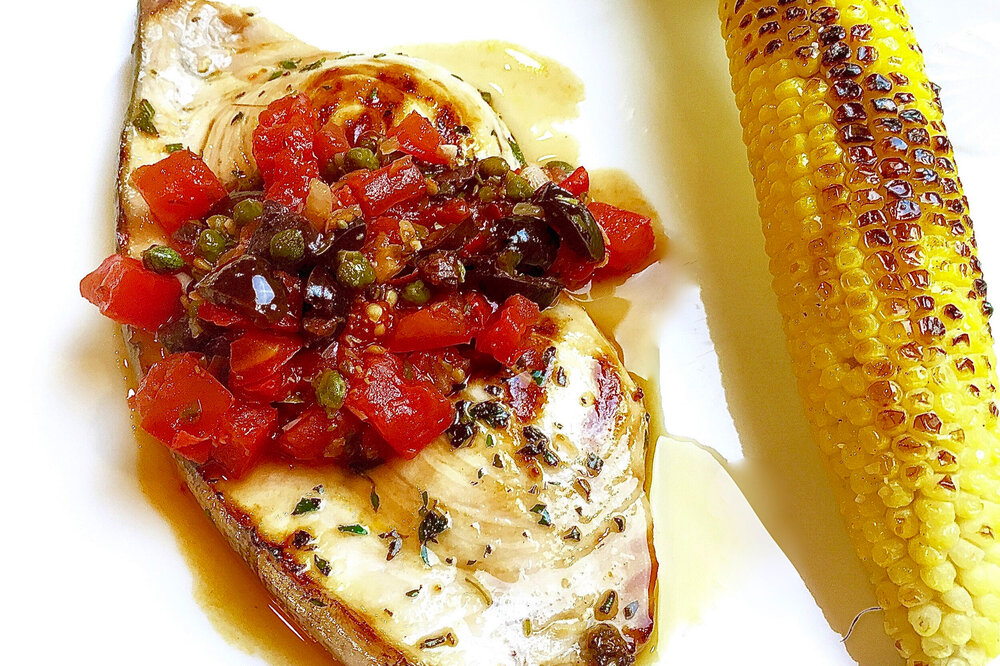
When the good Lord begins to doubt the world, he remembers that he created Provence.
One of my favorite food and wine pairings during the Summer months is a Tuna Niçoise Salad paired with a dry, Provençal rosé - it is sheer Summer deliciousness! But why limit the wonderful Niçoise flavors to just ONE dish? That just doesn’t seem fair. So when a friend kindly offered us some fresh swordfish steaks, these delicious flavors immediately sprang to mind as we happily accepted his oh so generous offer.
Niçoise (pronounced nee-SWAZ) essentially means "in the style of Nice," the fabulous French city located in the luxurious Côte d'Azur. Dishes labeled as such typically include a combination of traditional, local ingredients such as black olives, capers, garlic, tomatoes and anchovies. This recipe for Swordfish Niçoise includes a delicious mixture of black olives, tomatoes, capers, garlic, shallots and a little Herbes de Provence which beautifully complements the flavor and texture of the succulent fish.
Herbes de Provence is a delightful mixture of dried herbs typically found in the Provence region including savory, marjoram, rosemary, thyme, oregano and lavender. It is usually sold in a traditional clay pot and greatly enhances the flavor of dishes ranging from grilled fish to savory stews.

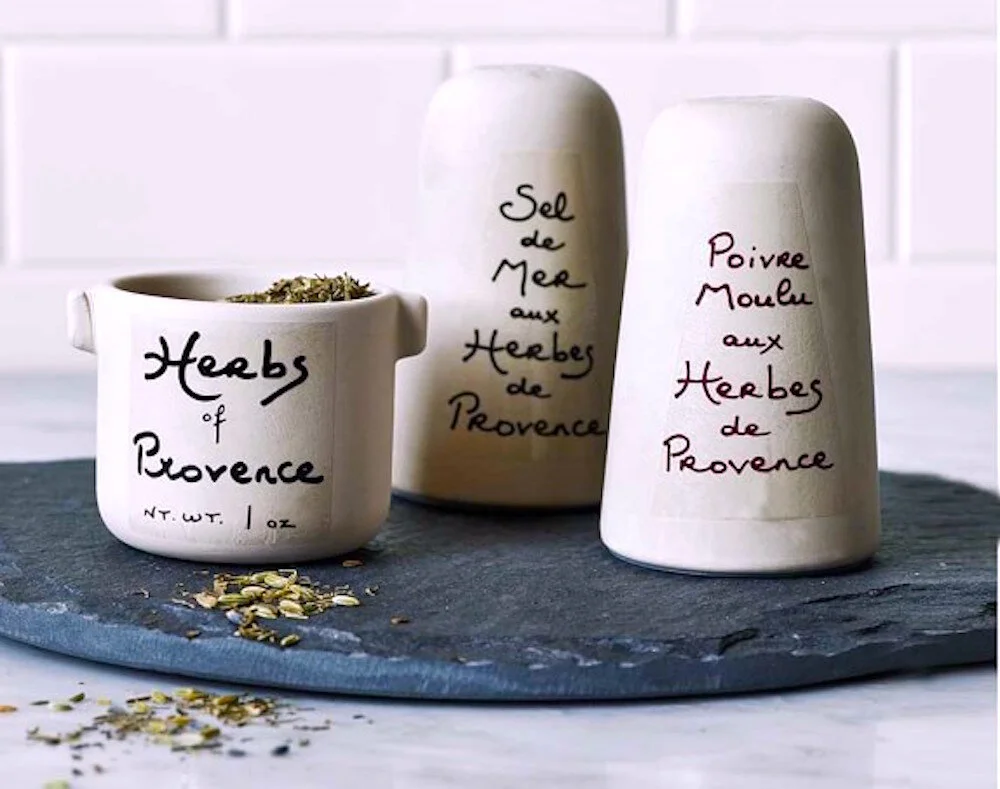
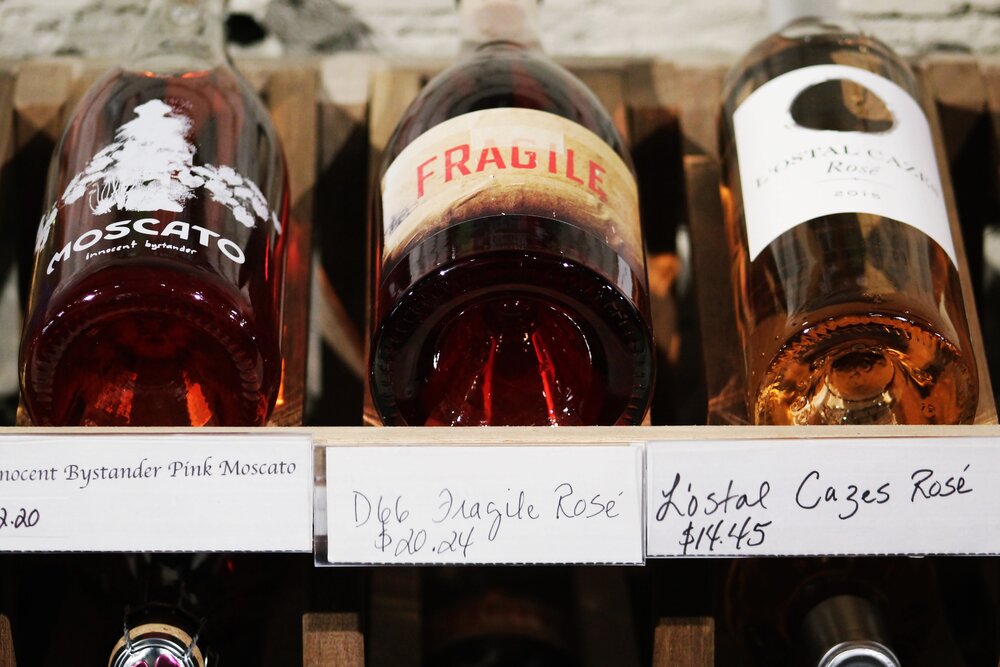
We served the Swordfish Niçoise with my husband's favorite Summer staple - corn on the cob! We cooked the sweet, yellow corn on the grill, allowing for a little "char" for added flavor and then slathered it with butter and a healthy dusting of Kosher salt and freshly ground black pepper before greedily consuming. Talk about simple but oh so very perfect!
To wash everything down and round out our Perfect Pairing, I stuck with one of my favorite pairing principles, if it grows together, it goes together! A refreshing glass of dry, Provencal rosé accentuates the dish’s flavors beautifully. On this particular evening we enjoyed the Miraval Rosé, the well-known Provençal winechild of Brad and Angelina, but any tasty dry rosé will do. Our favorite Provençal producers include Chateau Minuty and Chateau D’Esclans.
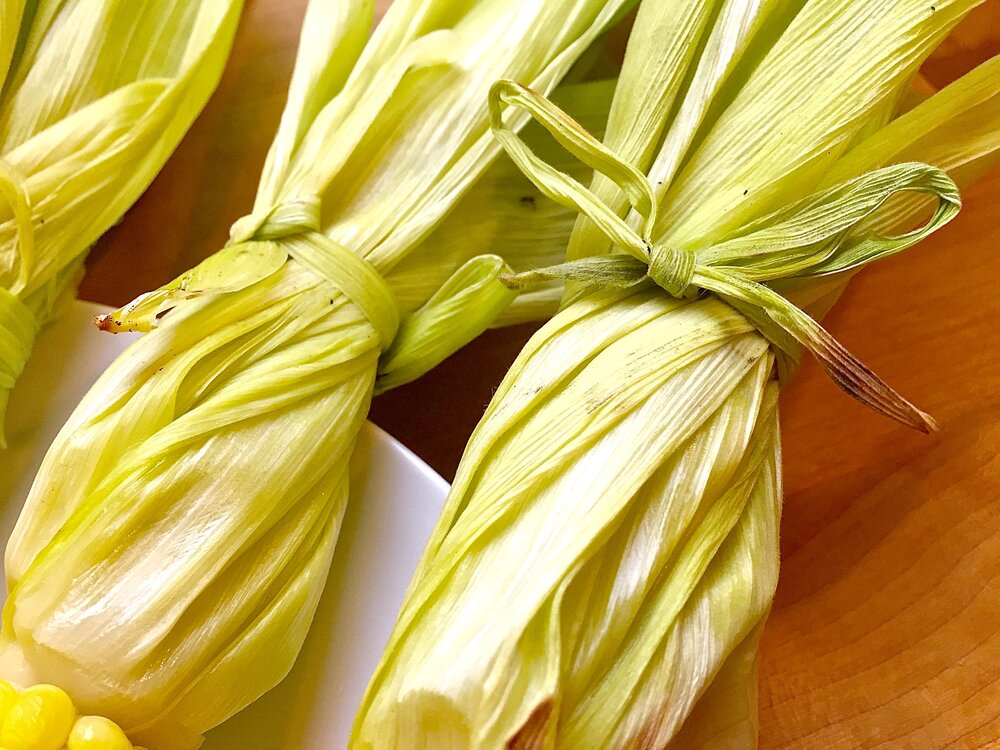
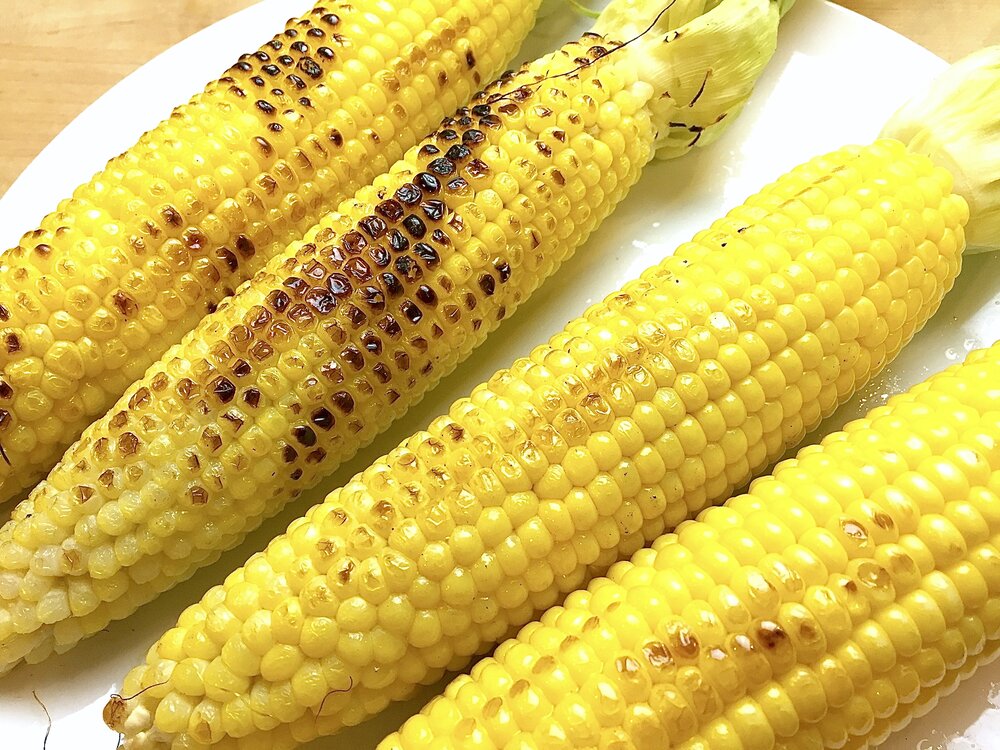
Before Summer draws to a close, I hope you have the chance to enjoy our Perfect Pairing of Swordfish Niçoise and a Provençal Rosé. In fact, why not invite a few friends over for an al fresco dinner and have everyone bring a bottle of their favorite rosé wine? What a great way to share your favorite and possibly discover a new one! What's your favorite Summer food and wine pairing? I'd love to hear about it in the comments section below!
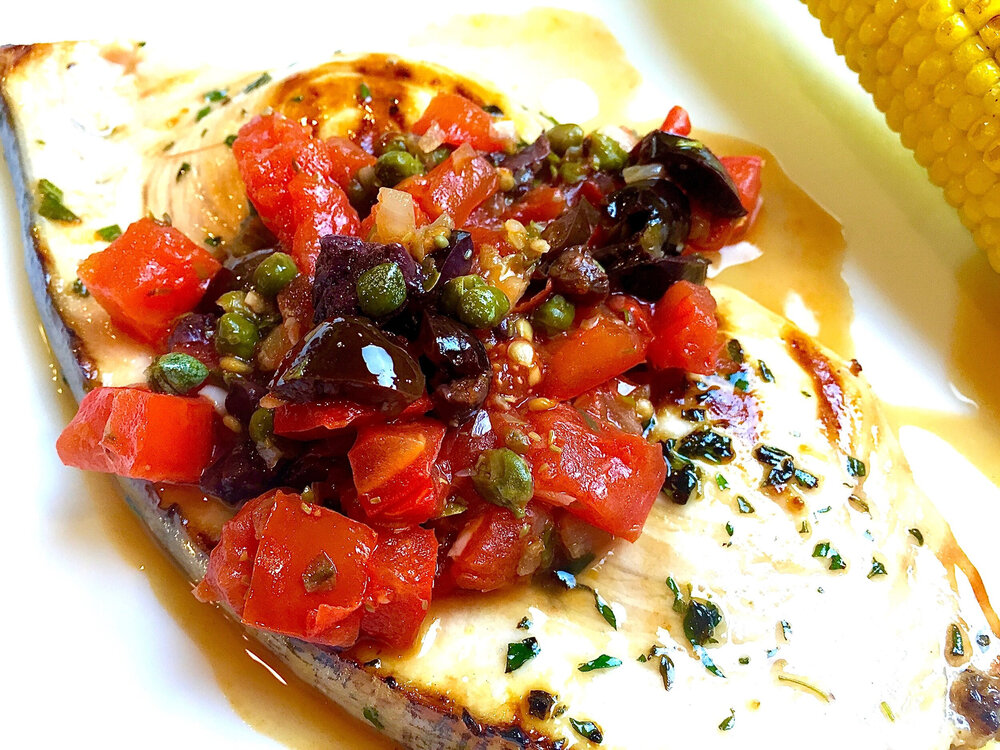
"PERFECT PAIRINGS: SWORDFISH NIÇOISE + A PROVENCAL ROSÉ"
Stephanie Miskew | The Glamorous Gourmet
Serves: 2
Ingredients
2 Swordfish steaks
4 Tablespoons olive oil
1 teaspoon Herbes de Provence
1 teaspoon fresh thyme, chopped
1 teaspoon fresh rosemary, chopped
2 shallots, chopped
2 cloves of garlic, chopped
1/2 cup pitted oil-cured, black or Niçoise olives, roughly chopped
2 Tablespoons capers, drained and roughly chopped
3 ripe red tomatoes, chopped
1/2 cup dry rosé wine
Kosher salt & freshly ground black pepper
Instructions
) Combine 2 Tablespoons olive oil, thyme and rosemary in a glass baking dish. Place the swordfish steaks in the mixture and turn to coat on both sides. Marinate the steaks in the olive oil and herb mixture at room temperature for one hour.
) Heat remaining 2 Tablespoons of olive oil in a frying pan over medium heat. Add shallots and garlic and saute until softened but not browned, 5 minutes. Add tomatoes, olives, capers, Herbes de Provence and wine and stir to combine. Bring to a boil, then cover and reduce heat and simmer for approximately 10-15 minutes. Season sauce to taste with Kosher salt and black pepper.
) Heat grill pan or outdoor grill over medium-high heat. Season swordfish steaks on both sides with Kosher salt and black pepper and grill until medium-rare, approximately 4-5 minutes a side depending on the thickness of the steaks.
) Plate steaks and top with Niçoise sauce. Serve immediately with a glass of chilled Provençal Rosé.
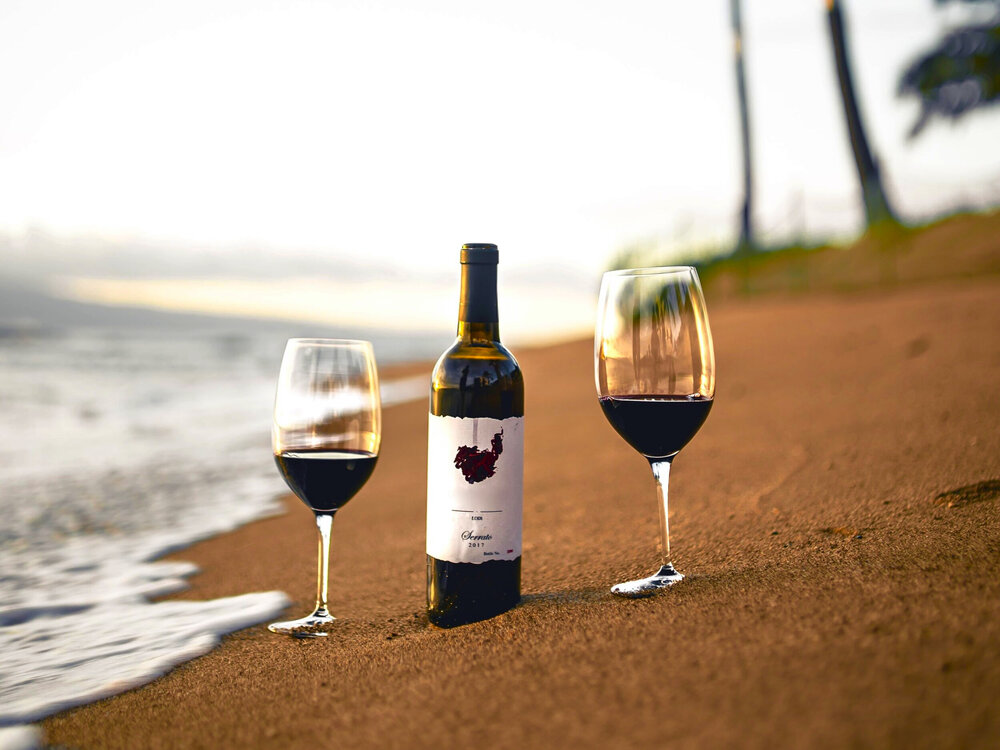
All worries are less with wine.
While rosé has quickly become Summer’s signature wine, with white wine coming in a close second, today I’ve got something for you die hard red wine lovers who would MUCH rather #Cabernetallday - even in 110 degree heat! And thanks to those of you who reached out to me about this topic because there are puh-lenty of positively delightful, seasonally-appropriate red wines from around the globe for you to enjoy this Summer and I’ve included some of my favorites in this post.
You can enjoy these beauties on their own (served with a slight chill, of course!), or paired with your favorite Summer dishes like meatier fish (i.e. swordfish, salmon), burgers and BBQ - the possibilities are truly endless…and oh so delicious!
Before we dive into the selections, here are a few tips to keep in mind when choosing a Summer red wine:
Opt for wines made from thinner-skinned red grape varieties such as Pinot Noir, Gamay and Barbera which produce light- to medium-bodied red wines with minimal tannins that are much more refreshing in the heat of Summer.
Avoid heavily oaked red wines. French oak imparts notes of baking spices such as clove, cinnamon and allspice as well as a richer, more viscous texture which is more of a #Fallthang. Summer reds should exhibit a nice balance between fruit and acidity with only a kiss of tannin!
Keep an eye on that ABV! If you’re spending the day at the beach or lounging by the pool you don’t want to get prematurely #daydrunk because a wine’s alcohol level is off the charts. Stick with reds 14.5% or lower and you’ll be able to enjoy AND remember your Summer day.
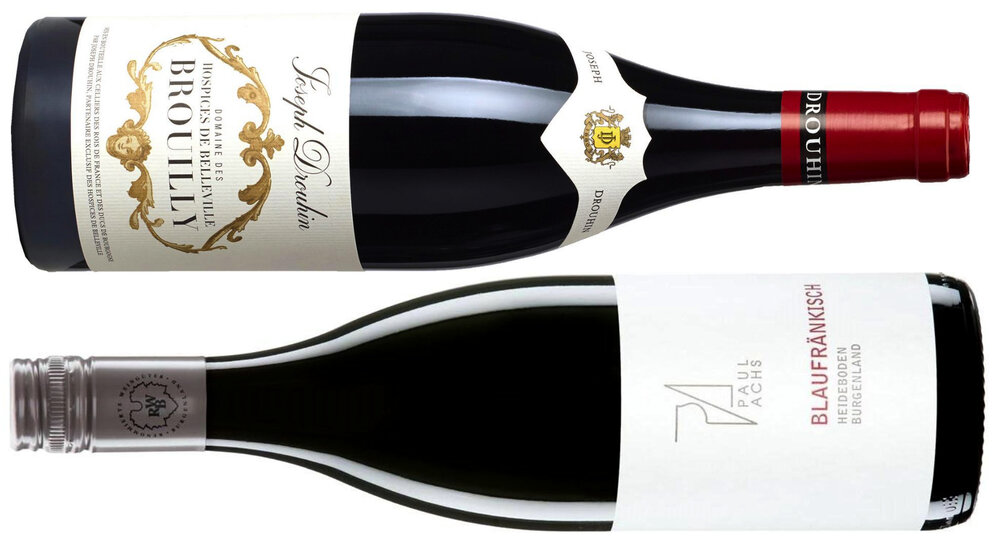
1.) Maison Joseph Drouhin Hospices de Belleville Brouilly, Beaujolais, France ($25): One of the best Summer pandemic #winegoals you can have is to get to know cru Beaujolais - NOT Beaujolais Nouveau - CRU Beaujolais! These wines hail from specific villages or “crus” (there are 10 of them!) within the southernmost part of Burgundy and are crafted entirely from the Gamay grape that produces utterly charming, light- to medium bodied reds that are vibrant, fruity and delicious. This exclusive partnership between Maison Joseph Drouhin and the Hospices de Belleville is worth seeking out with notes of black cherry, wild strawberry, violets and spice - for maximum enjoyment, serve slightly chilled!
2.) Paul Achs Blaufränkisch Heideboden, Burgenland, Austria ($19): Please don’t let the name deter you! The Blaufränkisch grape is one of my Summer faves and it might just become yours too! This indigenous Austrian grape produces medium-bodied red wines known for having oodles of lush, dark fruit (i.e. blackberry, black cherry and plum) accentuated by notes of black pepper, herbs and flowers. And in the hands of esteemed winemaker Paul Achs, you really can’t go wrong! Opt for youthful examples of Blaufränkisch like this one which are guaranteed to charm you with their lively acidity and soft, approachable tannins.
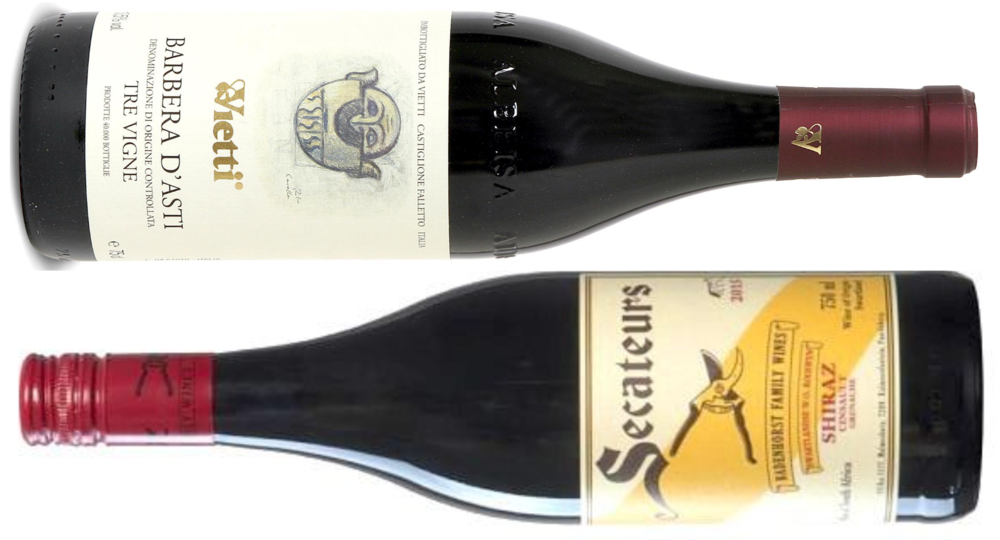
3.) Vietti Barbera d’Asti Tre Vigne, Piedmont, Italy ($18): If you are new to the Barbera grape, this delightful Italian red will immediately win(e) you over! Not to be confused with the Nebbiolo-based Barolo and Barbaresco wines which hail from the same region and require ample aging, Barbera (which is the name of the grape AND the wine) is ready to drink young. These alluring, medium-bodied gems are known for their racy acidity, soft tannins and charming, fruity character. This incarnation from the legendary Vietti family display notes of black currant, black cherry, violet and cassis with a lengthy, spice-tinged finish that’ll have you coming back for more!
4.) A.A. Badenhorst Secateurs Red Blend, Swartland, South Africa ($17): The Secateurs line of wines, named for the tool used to prune back the vines in the Winter and harvest ripe grapes in the Summer, from cousins Adi and Hein Badenhorst is, simply put, sheer Summer perfection! I mentioned the Secateurs Chenin Blanc in my Summer white wine post and the red, a juicy blend of Cinsault (82%), Shiraz (10%) and Grenache (8%), is equally delicious. Fragrant aromas of ripe red fruit and spice are followed on the palate by savory flavors of ripe red cherry, red currant and pomegranate with hints of anise and spice with a supple, smooth mouthfeel.
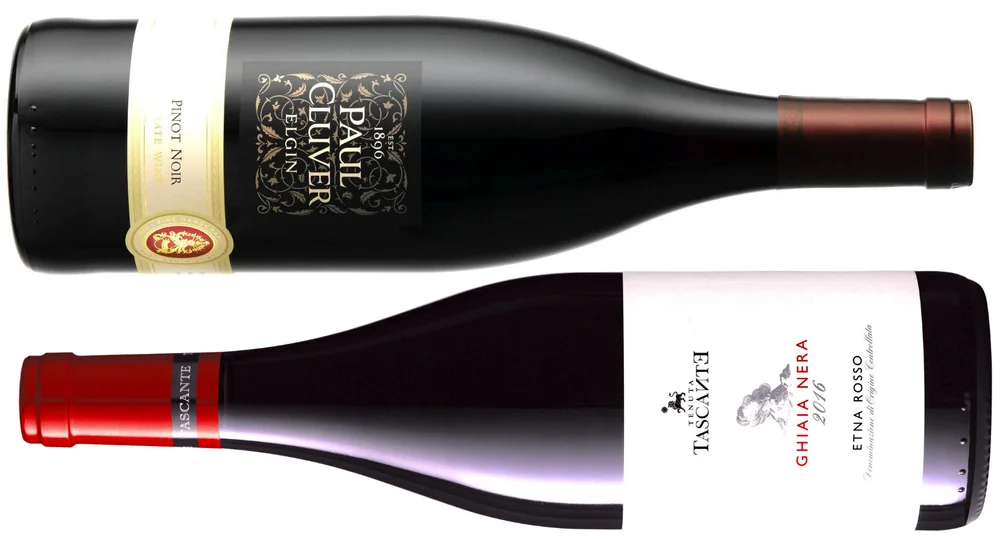
5.) Paul Cluver Estate Pinot Noir, Elgin, South Africa ($24): Pinot Noir has the ethereal lightness that’s so desirable in a Summer red wine but often at a very high price. Enter the wines of Paul Cluver! This 4th generation family has been farming in the Elgin Valley for 120 year and were the first to pioneer it as a fine wine region. The region’s cool climate is perfect for growing the finicky Pinot Noir grape and Cluver focuses exclusively on Burgundian clones. This gem of a wine is 100% Pinot Noir aged in a combination of (25%) new and used French oak barrels and the end result is a delightful, medium-bodied wine with classic notes of red cherry, cranberry, earth and spice.
6.) Tasca d’Almerita Tascante Etna Rosso Ghaia Nera, Sicily, Italy ($20): Sicily seems to be a never-ending source of intriguing grapes like this red beauty: Nerello Mascalese. Producing wines I would describe as Pinot Noir meets Nebbiolo, its wines can be fruity, herbaceous, spicy and floral all at the same time and, perhaps most importantly, imminently enjoyable. The wine’s pale color belies its power, leading you to believe you’re in for a wimpy wine but that couldn’t be farther from the truth! Instead, this wine delights with robust aromas and flavors of black cherry, wild strawberry, spice + volcanic ash accentuated by a tangy acidity and lithe tannins.
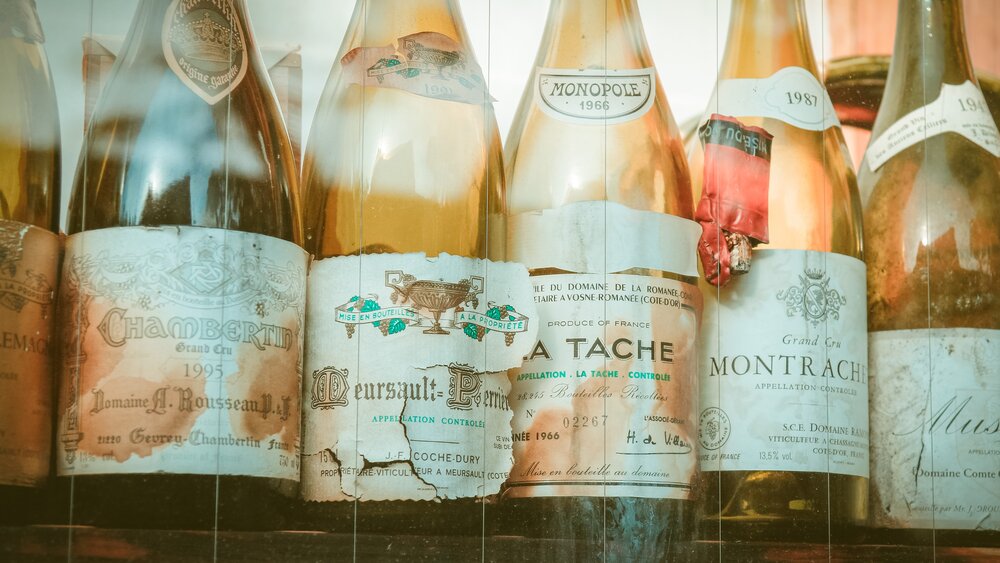
Everybody’s palate is different, but nobody’s palate is wrong.
Wine can be a pretty intimidating subject. The sheer volume of information involved in its mastery is daunting enough but when you add a cadre of wine snobs and aloof Sommeliers to the mix, yep it’s official. I remember when I decided to get serious about wine and make it my career, those first few trade events and study groups were terrifying! But over time, I put in the work and earned my credentials, all while pledging to make the world of wine as unintimidating as possible for my readers, family and friends. Wine should be a source of pleasure and discovering which wines you like (and WHY!), can be a lot of fun as well as the key to feeling truly empowered.
So just imagine a day where you no longer have to rely on your spouse or friend to tell you which wine to order. Picture yourself confidently bellying up to the bar and ordering a glass of Trockenbeerenauslese…or Pinot Noir depending on how you roll. So if you’re interested in embarking on this wine-soaked journey towards vinous enlightenment, I’ve got six essential tips to Empowering your Palate that are going to help you learn about the world of wine and, most importantly, lead you to discover which wines YOU truly love!
In order to truly empower your palate and experience the world of wine, you’re going to have to forego the tried and true, break out of your wine rut and start tasting lots of different wines. That’s not to say you should just randomly choose wines based on the critter or picture on the label – no, not at all! You just need to start tasting different wines from a variety of wine regions that are recommended by your “go to” websites, resources and people whose opinions you trust and respect in order to make an informed decision.
Here on my website I’ve got lots of helpful resources to guide your tasting exercises including blog posts (a great place to start is with White Wine 101, Red Wine 101 and Champagne + Sparkling Wine 101), podcast episodes and mini video masterclasses on a host of wine regions, producers and styles of wine. And please scroll down for even more helpful resources and advice on empowering your palate!
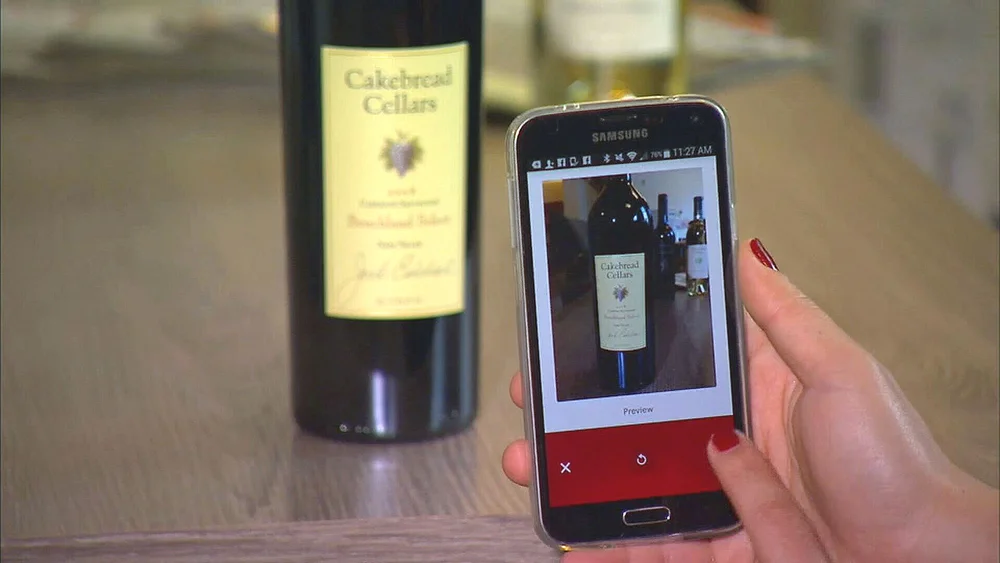
You’re out drinking wine with friends (properly social-distanced of course!) and you try a wine that truly wows you. You love it so much you’re absolutely sure you’ll remember the name of the producer and what the label looks like. But, not surprisingly, the next morning through your vinous haze you just can’t remember a darn thing about that wine! (I’ve been there too!)
This is precisely why, the moment you discover a wine that delights you, either write down the name of the wine and/or producer in the “Notes” section of your iPhone or, even better, snap a photo of it. Having that photo is your key to finding that wine again or getting something that’s very similar. So create a new folder in your photo app labeled “Wine” and, in time, you’ll develop a library of images that’ll tell the story of your unique vinous preferences. You can use this valuable information to help determine which wines you’re likely to enjoy in the future. You can also use wine apps like Delectable (my personal fave!), Wine-Searcher and Vivino that have loyal communities of wine lovers and experts to guide you as well.
This is perhaps the most important tip to vinous empowerment! In the process of discovering which wines truly make your palate sing, you’ll need a guide by your side since I can’t always be there with you (darn!). Because as you may have already discovered, many wines you read about on websites, in books or in magazines are not available at your local retail store. This is mostly due to antiquated wine laws that prevent retailers from having open access to whatever wines they want and unfortunately there’s no sign of anything changing anytime soon.
That’s why it helps to have someone who’s local and easily accessible who can reliably guide you to a similar selection in the event the wine you’re looking for isn’t available. The beauty is, over time, you’ll become more confident discussing wine and they’ll become familiar with your palate and will be able to anticipate and recommend wines you’ll like in the future based on your purchase profile with them. And I know they’ll really appreciate your business right now, and conveniently, many of them deliver now too!

Now that we’re all supposed to be sticking closer to home, it’s the perfect time to catch up on your reading! And there’s SO many amazingly delicious wine resources to dive into. A great place to start here on my website is with my posts that cover the basics: White Wine 101, Red Wine 101 and Champagne + Sparkling Wine 101. Other resources I greatly admire in the wine world by some of my favorite experts include:
The Wine Bible ($18) by truly fabulous innovator + wine expert, Karen MacNeil. You’ll thoroughly enjoy her charismatic writing style, plus she enjoys a glass of Champagne every day of her life so I love her for that as well! You can also click here for my interview with her to learn more about her fascinating journey as one of the first female wine writers.
The Oxford Companion to Wine ($49) and Wine Grapes: A Complete Guide to 1,368 Vine Varieties ($129) by the legendary Jancis Robinson
Wine Simple: A Totally Approachable Guide from a World Class Sommelier ($20) by the uber-brilliant yet down to earth Sommelier of Le Bernardin in NYC, Aldo Sohm.
Anything written by Master Sommelier Andrea Immer Robinson.
Of course you can also listen to podcasts which are perfect if you’re on the go or pedaling away on your Peloton! Of course I highly recommend my podcast, The Wine Atelier, but some of my other favorites include Levi Dalton’s “I’ll Drink to That,” and the Guild of Sommeliers podcast.
This tip generally would have read “attend all the wine events you can afford and/or have time for,” however, given our new, altered reality, virtual tasting are definitely the way to go - and I have to say, they are fabulous! I’ve been on both the attending and delivering end of virtual tastings and the sense of conviviality you experience at an “in-person” wine tasting can definitely be achieved at virtual events as well.
Some of my favorite entities that are hosting regular “virtual” wine tastings right now include:
EATER at Home Virtual Food + Wine Events on Instagram: Updated every Monday, the Eater at Home live tastings feature some of the food and wine world’s most well-known names such as Samin Nosrat, Alex Guarnaschelli and Andrew Zimmern.
Coravin Virtual Wine Events: Headed by Greg Lambrecht, inventor of the Coravin which revolutionized the way we taste wine. He has created a nice lineup of hosts whose goal it to create special moments of connection over a glass of wine.
Corkbuzz: The fabulous NYC-based restaurant and wine bar founded by female Master Sommelier, Laura Maniec.
Charlie Palmer’s Pigs + Pinot Tutorial Series: Every Thursday @ 4pm ET Chef Palmer and a rotating lineup of prominent Sonoma winemakers for the inside scoop on our favorite pork and pinot pairings.
The Boisset Collection: The charismatic Jean-Charles Boisset hosts daily Happy Hour wine tastings on Facebook Live @ 6pm PDT where he opens bottles and takes questions from viewers.
Wine makes daily living easier, less hurried, with fewer tensions + more tolerance.
While attending virtual events and tastings is really fun and you’re probably learning something new during each one, if you really want to kick it up a notch, taking formal wine classes is the way to go!
Wine & Spirit Education Trust: WSET provides globally recognized education and qualifications in wines, spirits and sake, for professionals as well as enthusiasts. They have a variety of different levels of certification that you can start at based on your existing level of proficiency. I currently hold the WSET Advanced Certificate which involved a blind tasting of two wines and a written exam consisting of a multiple choice section and an essay paper. These courses focus on materials best suited to teaching and writing about wine since there is no service component to them. If you’re interested in working in a service capacity, check out the next organization.
The Court of Master Sommeliers: Made famous by the 2012 movie SOMM, this globally recognized organization is considered the benchmark as far as wine service goes. And while the Master Sommelier designation is the pinnacle of this organization (there are only 255 Master Sommeliers in the world!), there are three other preceding tiers of certification as well, the Intro level which is perfect for enthusiasts and those still considering a career in the wine industry, the Certified Sommelier level which is self-study only and the exam is a mini-version of the Master Somm exam, consisting of a blind tasting of two wines, a written theory portion and a service component.
The last level before the Master Sommelier is the Advanced Sommelier in which all three components of the exam, bling tasting, theory and service, must be passed at the same time and failing any one of them requires you to take the entire exam and all of its components over again.
The Institute of Masters of Wine (IMW): If the Master Sommelier is the highest certification in terms of service in the wine world, the Master of Wine is the highest level of certification in terms of academia and writing. The WSET diploma is often considered a prerequisite to being accepted into the MW program which culminates in a three-part examination, comprised of theory and practical components as well as a research paper. The theory papers touch on a comprehensive range of wine-related topics including viticulture and vinification, the business of wine and current trends in the wine industry. There are currently 394 MW’s in the world today.
Society of Wine Educators (SWE): As the title implies, this organization is focused on providing wine and spirits education along with the conferral of several certifications including the Certified Specialist of Wine (CSW), Certified Specialist of Spirits (CSS), Certified Wine Educator (CWE) and Certified Spirits Educator (CSE). The Society is internationally recognized and its programs are highly regarded for both their quality and relevance to the industry.
Wine Scholar Guild: This well-respected organization is considered the leading provider in specialized certification programs on the Old World wine regions of France, Italy and Spain with a school network spanning 30 countries and 5 continents. They’re definitely pioneers in online wine education and students learn from the best names in the wine industry. They also offer very exclusive wine study immersion programs on the market.
I hope you find these 6 essential tips for Empowering your Palate helpful and that these resources enhance your enjoyment and exploration of the wine world. Whether as a career or hobby, this is truly a topic you can easily devote your life to!
And if you’d like to receive weekly updates about the world of food and wine, simply click here to sign up for my newsletter. The GG Guide to Wine + Food will delight you with seasonally-inspired, Sommelier-curated recipes, wine recommendations, pairings and travel trips. xo
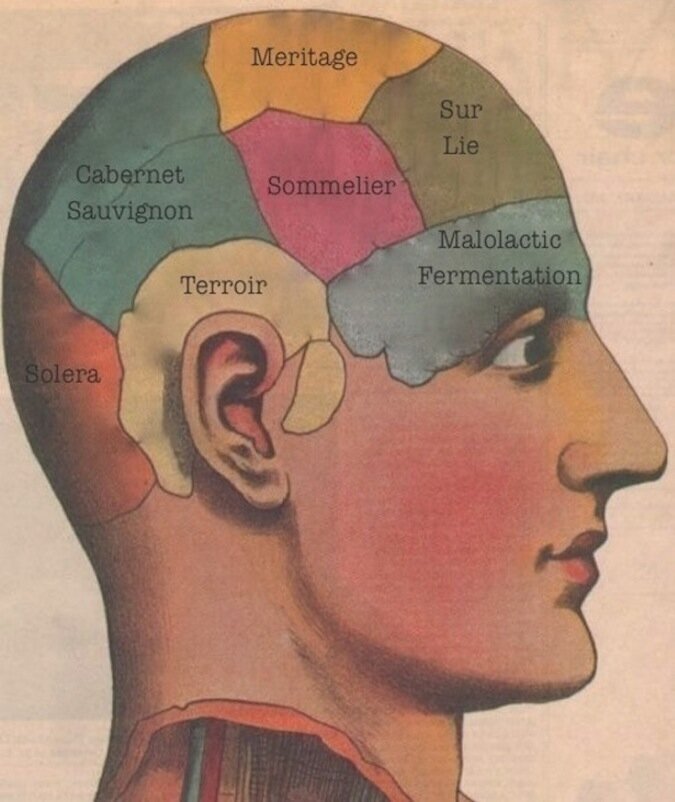


Key to learning about wine, sweet wines in particular, is a little term called Residual Sugar which is our Wine Word of the Week. While there are many factors that ultimately determine the perception of sweetness in wine, residual sugar is the actual amount of sugar left in a wine after the alcoholic fermentation - which can end in a variety of interesting ways.
During fermentation, yeast converts sugar into (1) alcohol and (2) carbon dioxide (yeast + sugar = alcohol & CO2). The carbon dioxide gas is generally allowed to dissipate (except in the case of sparkling wine) and the fermentation process is complete when either: (1) the yeast consumes all of the fermentable grape sugars, resulting in a dry wine, (2) the alcohol level becomes too toxic for the yeast and it dies, leaving some residual sugar in the wine; or (3) the winemaker halts the fermentation prematurely. In fortified wines for example, the winemaker halts the fermentation by the addition of a neutral grape spirit which kills the yeast, leaving oodles of residual sugar in the finished wine.
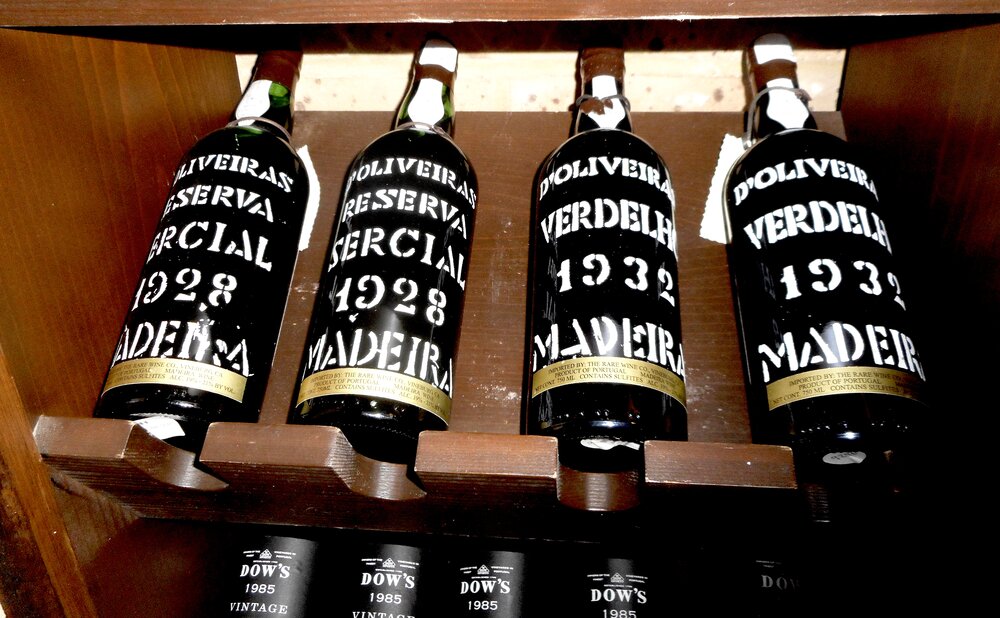
Residual sugar is often measured by either (1) percentage, or (2) grams per liter (aka g/L). Generally speaking, the threshold level for a wine to be considered sweet is around 35-45 g/L, although many sweet wines actually far surpass 150 g/L! And it's not uncommon for dry wines (dry meaning "not sweet") to contain low levels of residual sugar at imperceptible levels (i.e. 10 g/L), since some sugars are unfermentable.
WINE SNOB ALERT: Many Wine Snobs will refer to residual sugar as "RS" especially when they're in the company of someone they are trying to impress or intimidate. They've also been known to snidely ask the uninitiated, "Hmmm, do YOU detect some RS in the wine?" To which you should confidently reply, "Hmmm, I don't know, do YOU?"
Other factors can also affect the perception of sweetness in wine including acidity, tannin and alcohol. Acidity and tannin tend to mitigate the perception of sweetness, while alcohol can actually increase it. Some high acid wines that have high levels of residual sugar, such as Vouvray from the Loire Valley and German Riesling, can be perceived as dry because the sweetness is balanced by the acidity. Such is the case with sparkling wines as well.
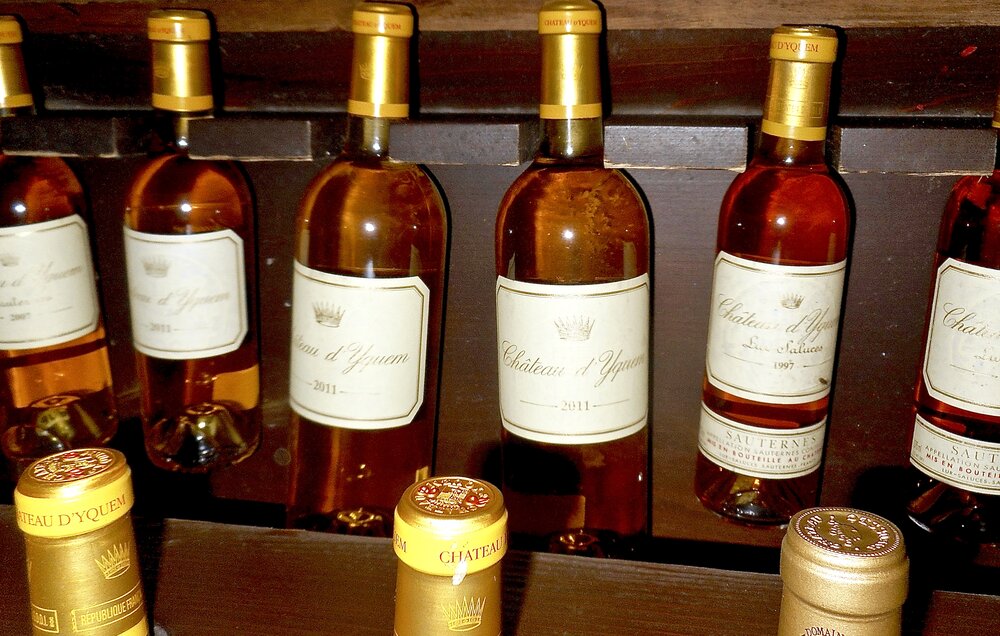
I hope you enjoyed learning about residual sugar, my latest Wine Word of the Week! And if you happen to know any wine lovers who'd like to learn more about wine, please feel free to share this post with them. And if there are any “wine words” you’d like to learn more about, please feel free to share them in the Comments section below and I'll do my best to demystify them for you.
To see previous WWOTW posts, please click here and, as always, thanks for reading!
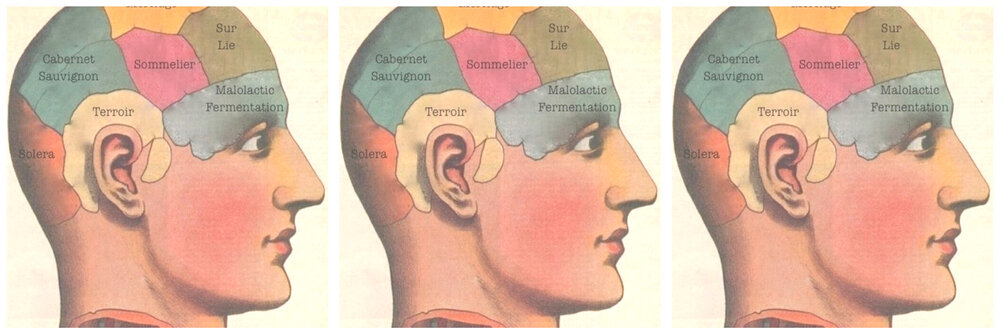
If you're anything like me, the word "clone" immediately conjures a host of 1970's B-movies featuring body-copying aliens seeking to wreak havoc on the human race. When it comes to grapes, however, that source of many 70's childhood nightmares couldn't be further from the truth. In fact, a GRAPE clone is actually a very good thing!
While most plants reproduce sexually (just picture it, candlelight, a good bottle of wine and Diana Krall's cover of "Peel me a Grape" playing in the background) resulting in a combination of genetic material from both parents, clones are created through asexual propagation, where an actual cutting or graft is taken from only one "mother" vine.
But why not let love run its natural course?
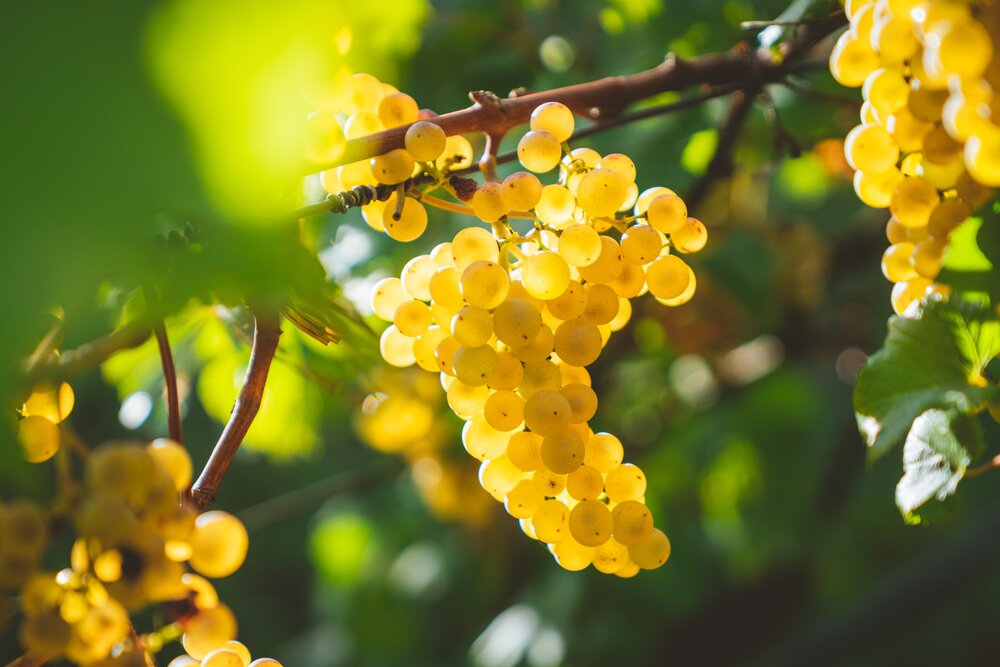
Cloning is done in order to replicate a beneficial trait or desired quality of a particular vine. These traits could include a vine's natural disease resistance, fruit maturation rate, desired berry and/or cluster size, or even a particular flavor or aroma depending on the style of wine a winemaker is aiming for. Theoretically, once this genetically identical cutting is planted, it will result in a vineyard brimming with fruit featuring the desired characteristics of the mother vine, right?
Unfortunately, it's not quite that simple (frownie face).
Slight variations commonly occur among the millions of cells that make up a grapevine. And even though a cutting should be genetically identical to its parent plant, random mutations sometimes occur in the new vine causing it to exhibit different, unexpected characteristics. These differences can be good or bad and if the difference happens to be good, the vine may be further propagated to perpetuate the desired quality. This new, distinctive clone is then assigned an identifier (which can be a number or a name) to distinguish it from other clones of the same grape variety.
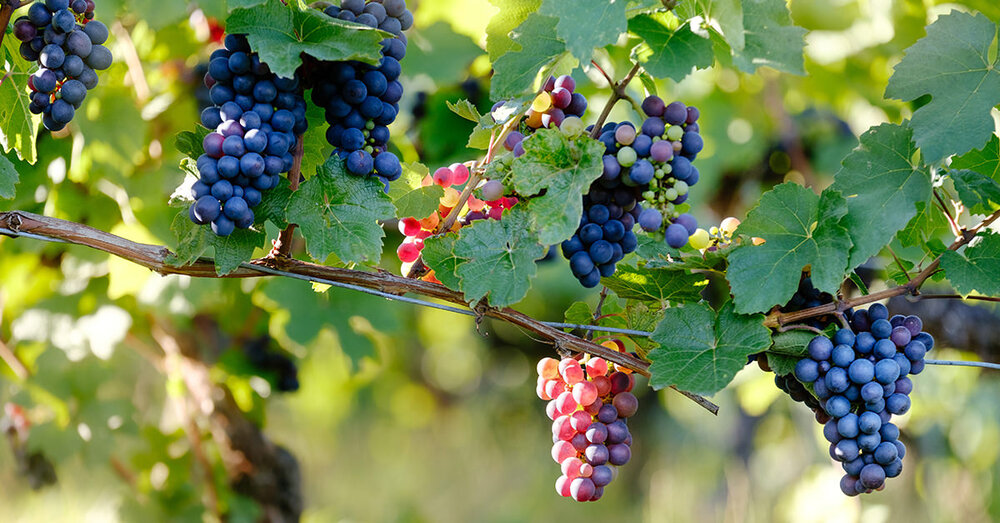
Although talk of grape clones has heretofore occurred mostly among members of the wine trade, viticulture professionals and extreme wine geeks, today it is becoming more mainstream among passionate wine enthusiasts. Know that, generally speaking, the older the grape, the more clones it will probably have, so Old World grapes like Chardonnay and Pinot Noir have quite a few. Some of the more popular "designer clones" you may encounter include Pinot Noir's Pommard, 115 and 777; Cabernet's 6 and 12, and Chardonnay's Old Wente, 4 and 5. For a deep dive on your favorite grape, simply Google the grape name followed by "grape clones" - Chardonnay alone returns 350,000 results!
I hope you enjoyed the latest Wine Word of the Week and if you have any “wine words” you’d like to learn more about, please feel free to share them in the Comments section below.
To see previous WWOTW posts, please click here and, as always, thanks for reading!
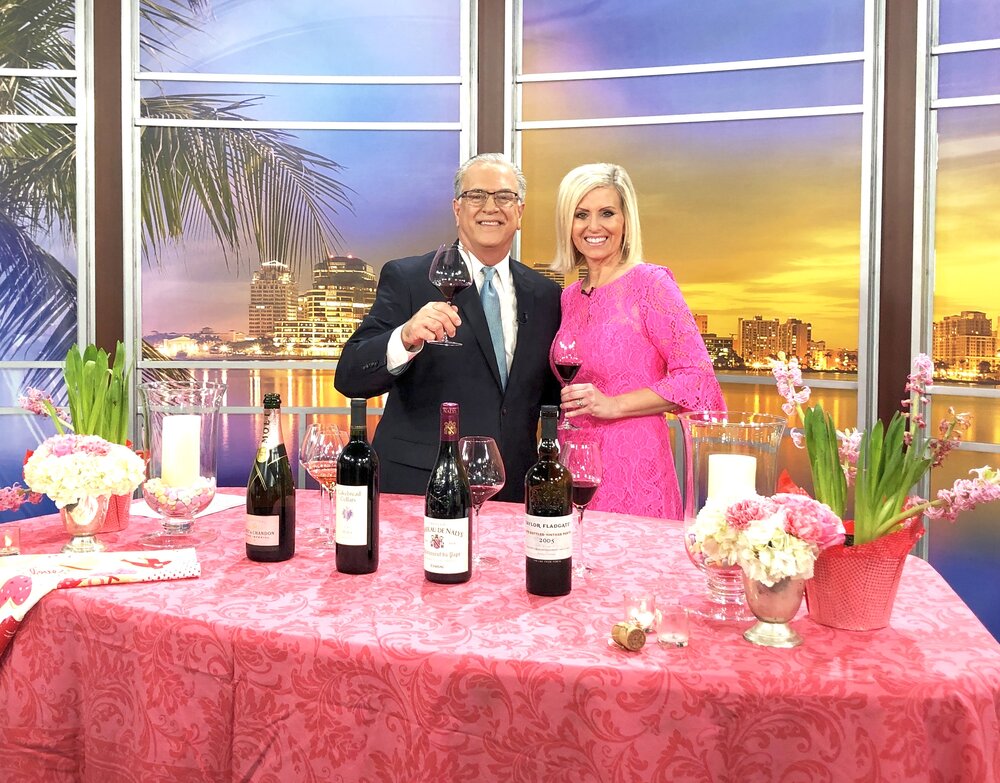
If you're looking for the perfect wines to set the mood for l'amour this Valentine's Day, check out my latest appearance on WPTV featuring my favorite Romantic Red Wines for Valentine's Day. In addition to the wine selections, I also explain the two reasons why red wines posses more aphrodisiac qualities than white wines and are naturally better for setting the mood for love.
The fabulous John Favole also asks some great questions about food pairings for these delicious wines so please check out the video below as well as the show notes below the video for all the details (and links to the food pairing recipes!).
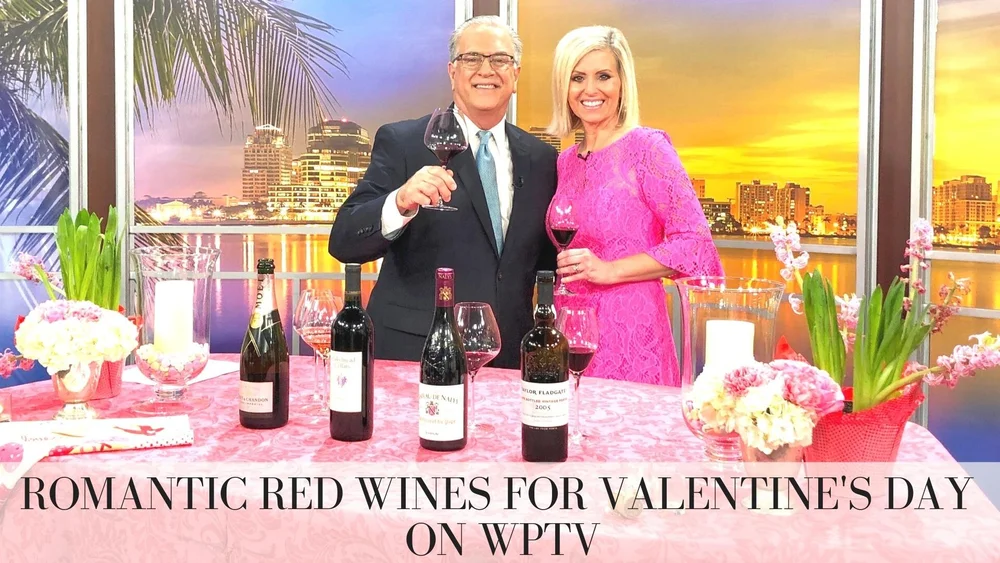
I hope you find my Romantic Red Wines for Valentine's Day recommendations helpful! Please see below for a list of all the wines featured in this episode as well as links to recipes.
This year's “Living Ties” Limited Edition bottle features beautiful black ties that represent the ties that bind together soulmates, family + friendships.
Made predominantly from the Pinot Noir grape, this beautiful pink Champagne gets its glorious color from the addition of 10% still red wine.
Enjoy this wine in a white wine glass (not a flute!) to fully appreciate the delightful aromas and flavors of the wine!
This delightful rosé Champagne has enticing notes of strawberries, raspberries, red currants, peach and a subtle note of spice and finished with a delightful crisp, dry finish!
Merlot is the perfect grape for Valentine's Day! It’s all about luscious, voluptuous ripe dark fruit like black cherry, blackberry and plum with an opulent, full-body.
Originally from France's Bordeaux wine region, Merlot gets hedonistically ripe in the warmer climates of California's Napa Valley.
This wine from the well-known Cakebread Cellars is a blend of 95% Merlot and 5% Cabernet Franc. It displays fragrant aromas of ripe black cherry, black currant and violet. It has rich, concentrated flavors of ripe blackberry, plum, black cherry and spice that fill the lush palate, framed by fine-grained tannins, culminating in a long finish.
Chateauneuf-du-pape produces delicious red wines from France’s Southern Rhone Valley. These wines are red blends that are predominantly based on the Grenache, Syrah and Mourvedre grapes although 13 grapes can legally be used.
This elegant, full-bodied stunner is crafted primarily from the estate's Old Vine Grenache with a dollop of Syrah, Mourvedre, Counoise and Vacarese which combine to create a rich, luxurious red wine.
This wine is full-bodied and velvety, with a lovely minerality and notes of dark cherry fruit, vanilla and sandalwood. Layers of spices including cinnamon, clove, licorice and allspice add depth of flavor and interest to the silky finish.
This is the most luscious of our featured wines and the most perfect for pairing with chocolate!
Port is a fortified wine (read this for more info) which means the wine has a higher alcohol content (approx 20%) and it is also lusciously sweet!
Unlike vintage Ports, Late Bottled Vintage Ports are bottled after 4-6 years in wood, giving them some of the characteristics of vintage Port but with less time required for bottle aging.
This wine has powerful, mouth-filling notes of dark cherry, ripe black fruit and chocolate with beautiful depth and complexity and a lengthy, spice-tinged finish.
Looking for romantic Valentine's Day dinner recipes for two? Check out these Fabulous Food Pairings:
This recipe for succulent Mustard Roasted Fish would be delicious paired with the Moët & Chandon Rosé Impérial Champagne!
Steak au Poivre à Deux with Roasted Rosemary Garlic Potatoes is perfect for pairing with the Cakebread Cellars Merlot or the Chateau de Nalys Chateauneuf-du-Pape!
Hoffman's DELIGHTFUL chocolates are perfect for pairing with the luscious Taylor Fladgate Port. For more detailed information on which chocolates pair best, please check out this video - OH the DECADENCE!!!
I hope you enjoy these Romantic Red Wines for Valentine's Day and I'd love to hear which wines are your favorites. If you enjoyed this video, please click here subscribe to my YouTube channel and/or click here to add your name to my weekly newsletter list. And most importantly, I hope you have a very Happy Valentine's Day!
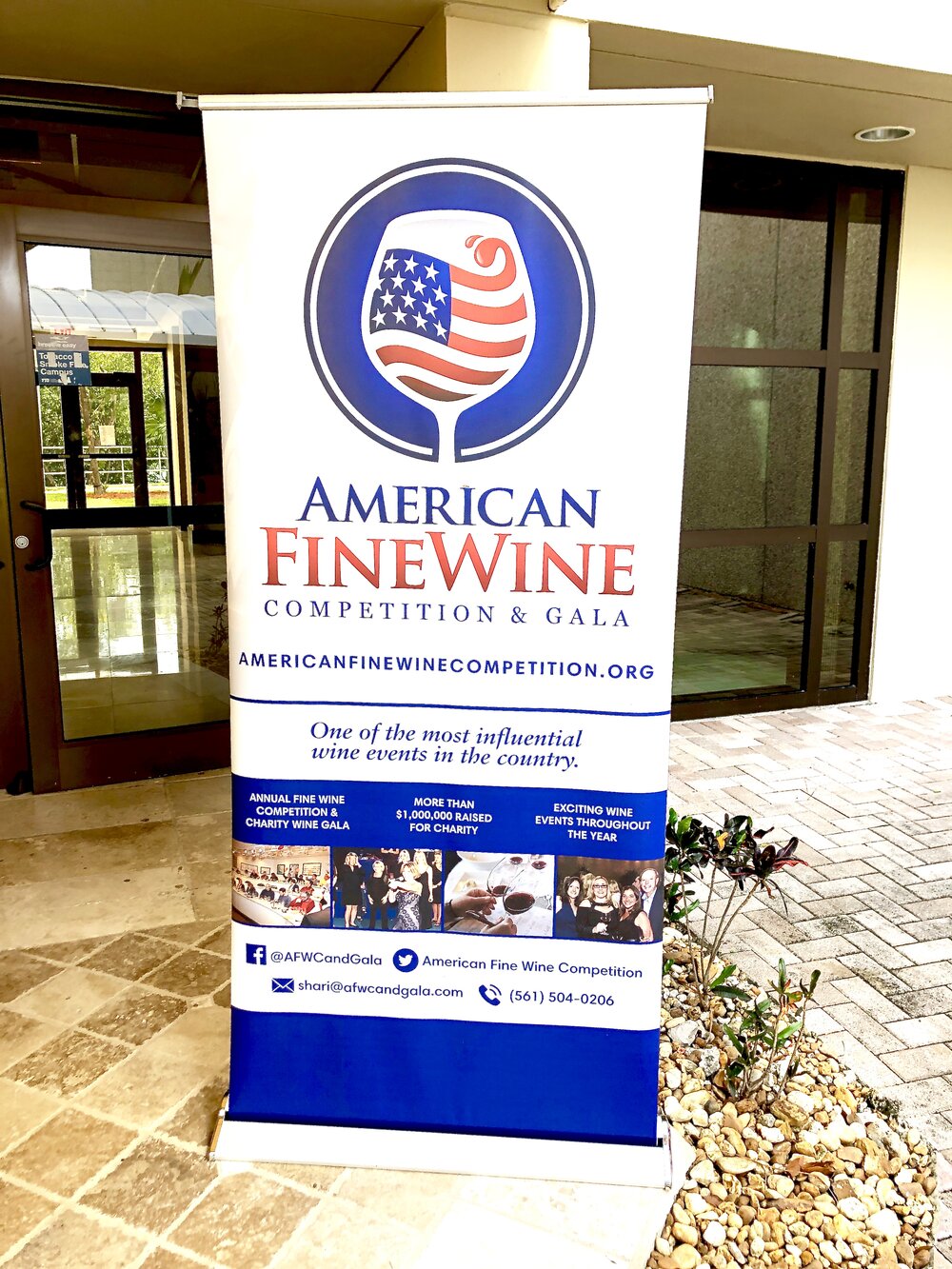
My fellow wine lover, it is with great pleasure that I reveal the results of the 12th Annual American Fine Wine Competition! As many of you know (especially if you're on Facebook or Instagram), the judging process took place last month at Florida International University’s Chaplin School of Hospitality.
And after two solid days of sipping, swishing and (mostly!) spitting we collectively judged over 700 wines from around country, thereby earning our indelibly purple-etched teeth. We tasted everything from Michigan Riesling to California Tempranillo hailing from both well established and up and coming wine regions. Given the exciting diversity of the entries, it’s always fascinating to learn the winners.
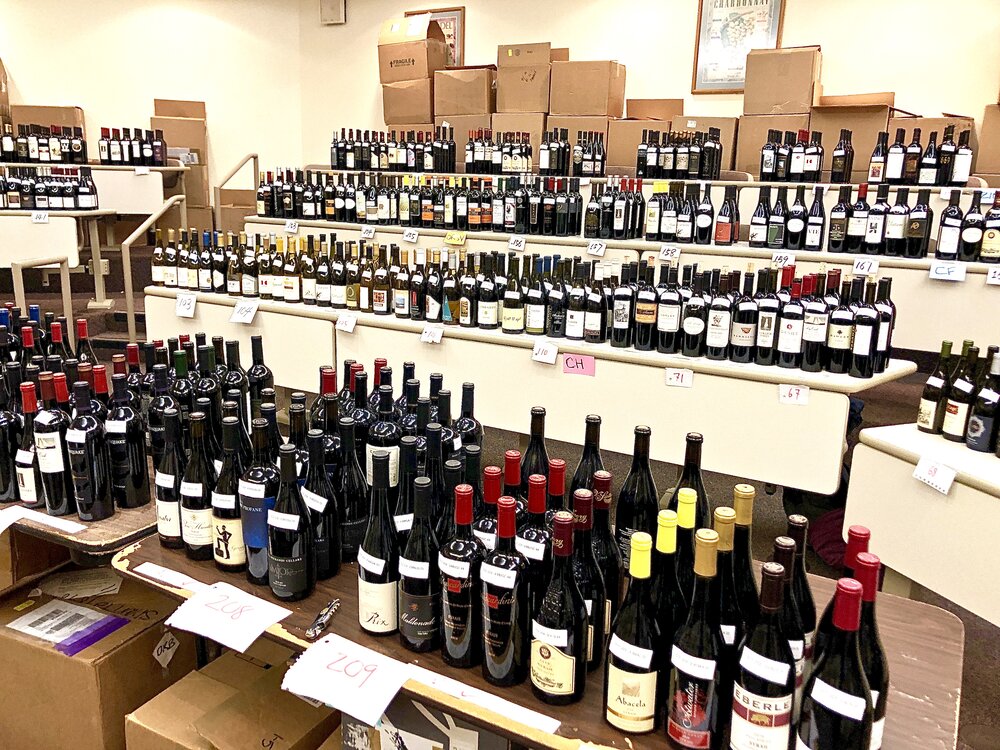
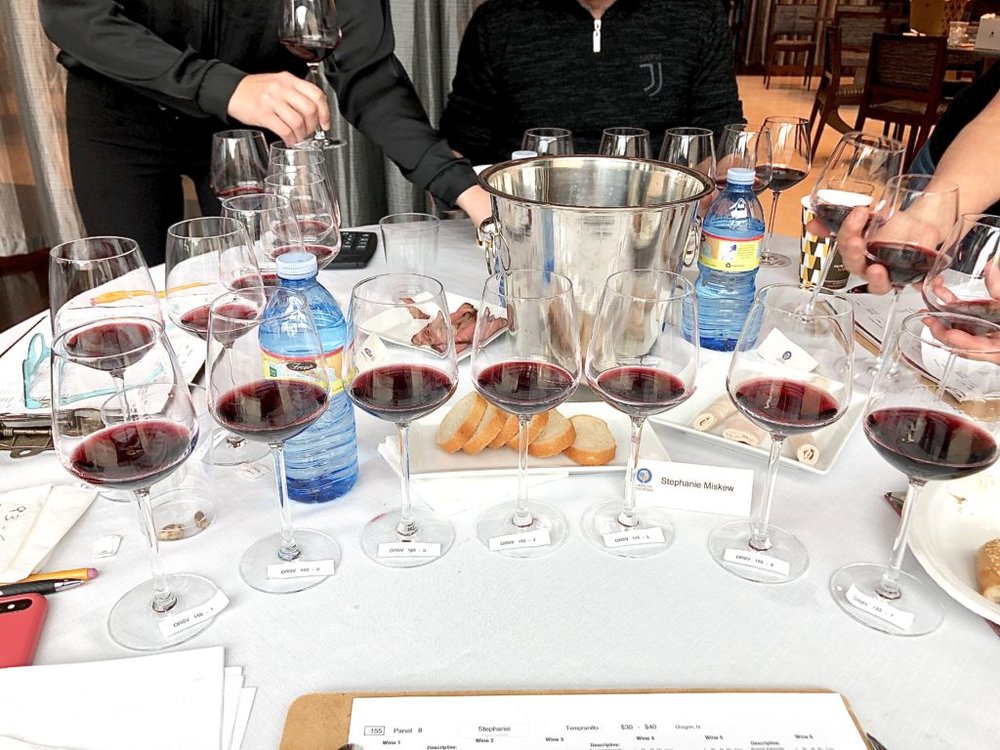
And in his third year as Chief Judge and Judging Coordinator of the AFWC, Greg Miseyko did a wonderful job presiding over the competition. Greg assumed the esteemed duties from competition Co-Founder Monty Preiser who still participates as a judge. And once again, Co-Founder and President, Shari Gherman executed the judges' tasting flawlessly. I continue to be amazed at how she choreographs the numerous flights of wines and their distribution to over 30 judges during the lengthy judging process - GO, Shari!
So without further ado, here are the results of the Best of Show and Best of Class categories for the 14th Annual American Fine Wine Competition. Please scroll all the way to the bottom for the link to the complete results:

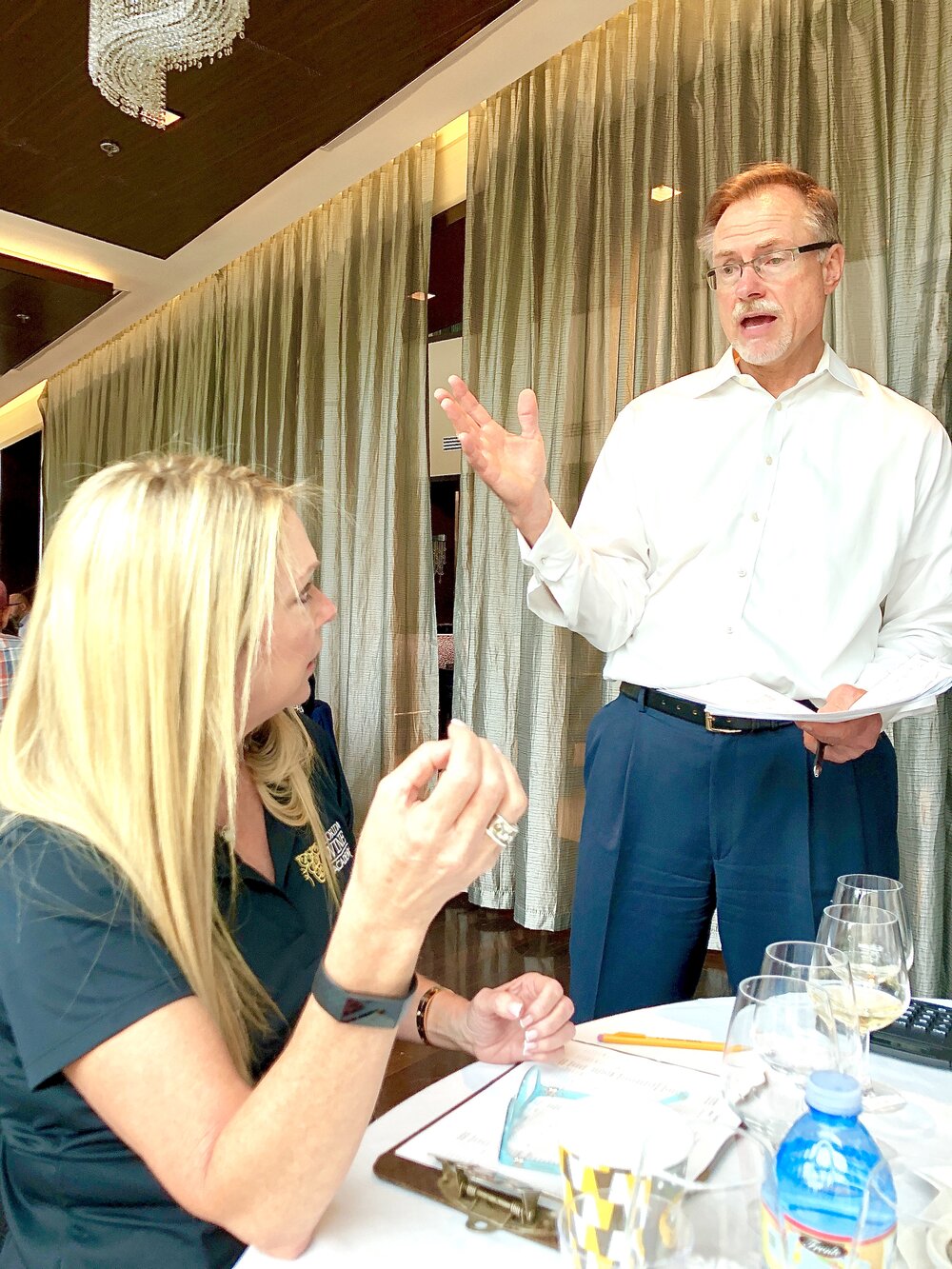
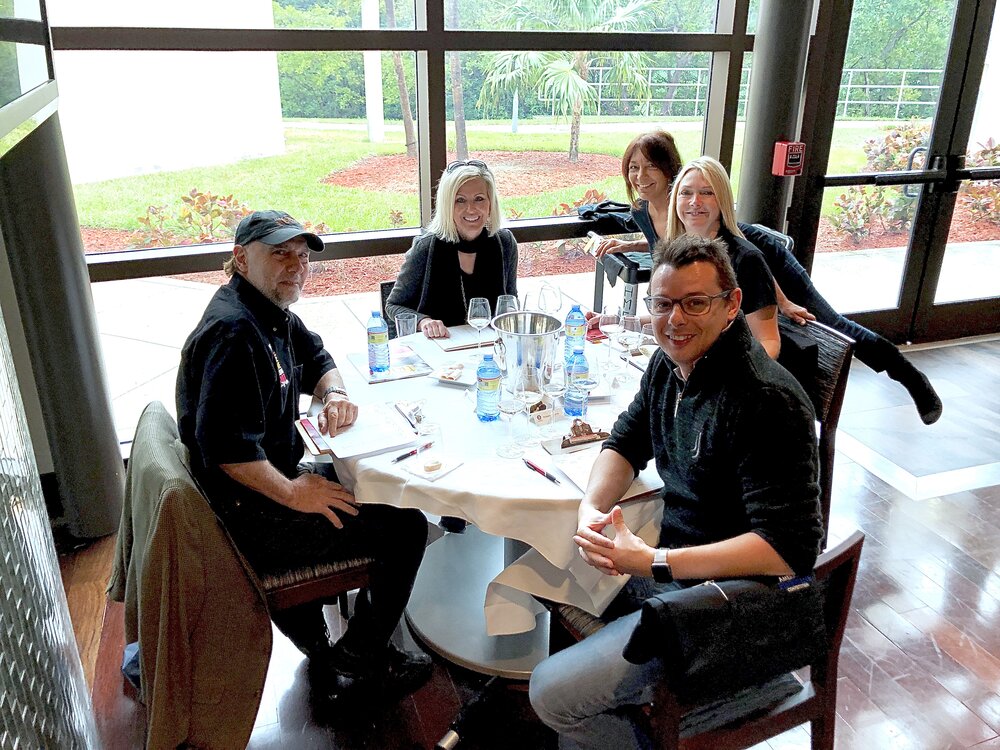
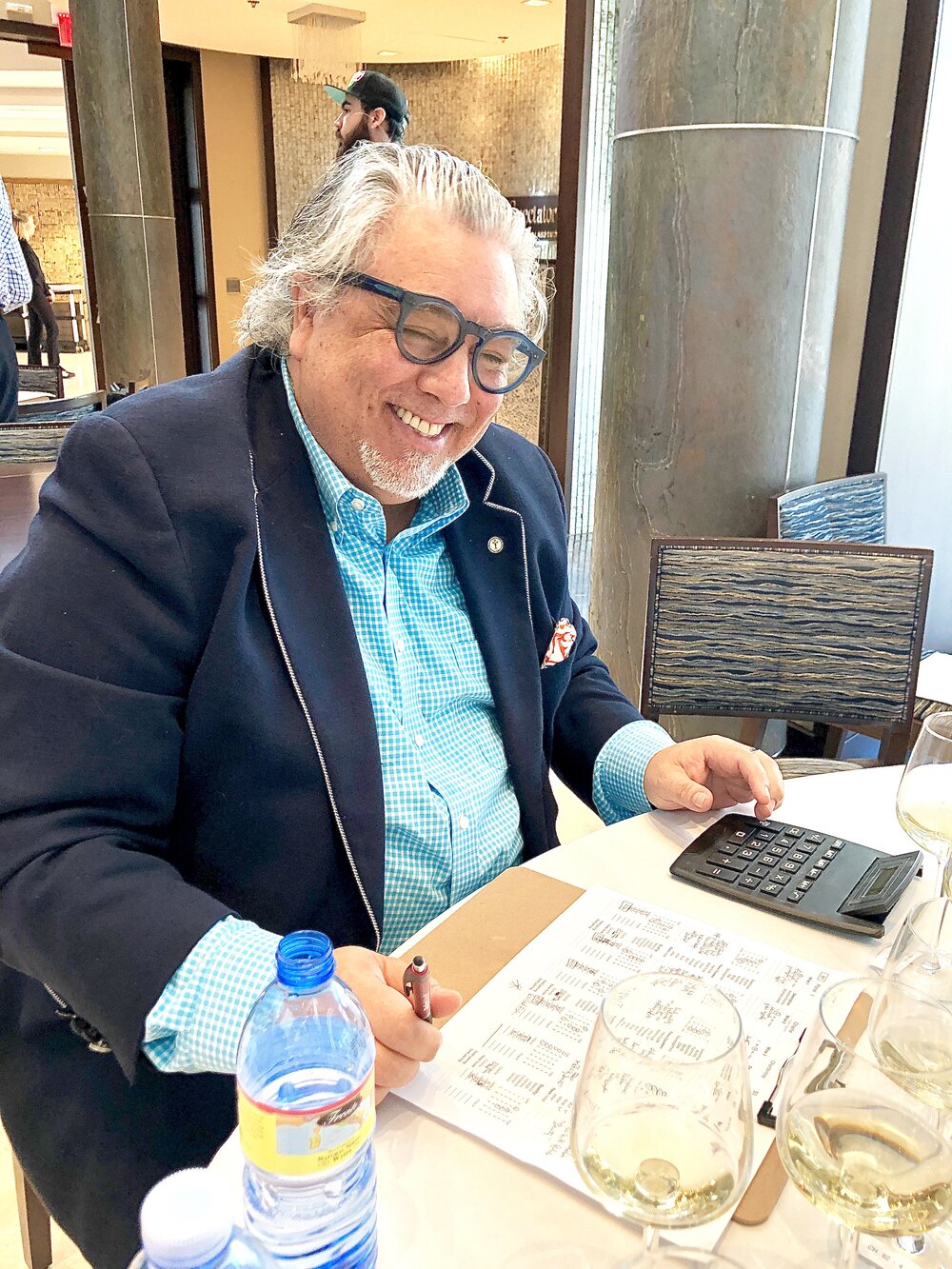
Best of Show Red Wine: Chase Cellars Stags Leap District Cabernet Sauvignon, Napa Valley, California, 2016 ($125)
Best of Show White Wine: Black Star Farms Arcturos Semi-Dry Riesling, Leelanau Peninsula, Michigan, 2016 ($14)
Best of Show Sparkling: Glenora Wine Cellars Brut, Finger Lakes, New York, 2013 ($30)
Best of Show Port: St. Amant Winery Lot #11 Amador County, Lodi, California, NV ($35)
Best of Class Cabernet Franc: Ancient Oak Cellars Alcaeus Cabernet Franc Sonoma Mountain, Sonoma, California, 2014 ($75)
Best of Class Bordeaux Blend: B Cellars Vineyards and Winery Blend 27 Napa Valley, Napa, California, 2016 ($87)
Best of Class Merlot: Raymond Vineyards Reserve Napa Valley Merlot, Napa, California, 2016 ($30)
Best of Class Petite Sirah: Ballentine Vineyards Pocai Vineyard Petite Sirah Calistoga, Napa Valley, California, 2016 ($45)
Best of Class Pinot Noir: Bee Hunter Wine Oppenlander Vineyard Pinot Noir, Mendocino, California, 2014 ($48)
Best of Class Syrah: Klinker Brick Winery Farrah Syrah, Lodi, California, 2015 ($20)
Best of Class Zinfandel: Michael David Winery Lust Zinfandel, Lodi, California, 2015 ($59)
Best of Class Other Red: V. Sattui Winery Entanglement GSM Blend, Napa Valley, California, 2016 ($40)
Best of Class Other White: Acquiesce Winery Belle Blanc Lodi Mokelumne River, Lodi, California, 2017 ($32)
Best of Class Sauvignon Blanc: Reustle Prayer Rock Vineyards Sauvignon Blanc, Umpqua Valley, Oregon, 2017 ($23)
Best of Class Chardonnay: Husic Vineyards Dutton Ranch Sonoma Coast Chardonnay, Sonoma, California, 2016 ($50)
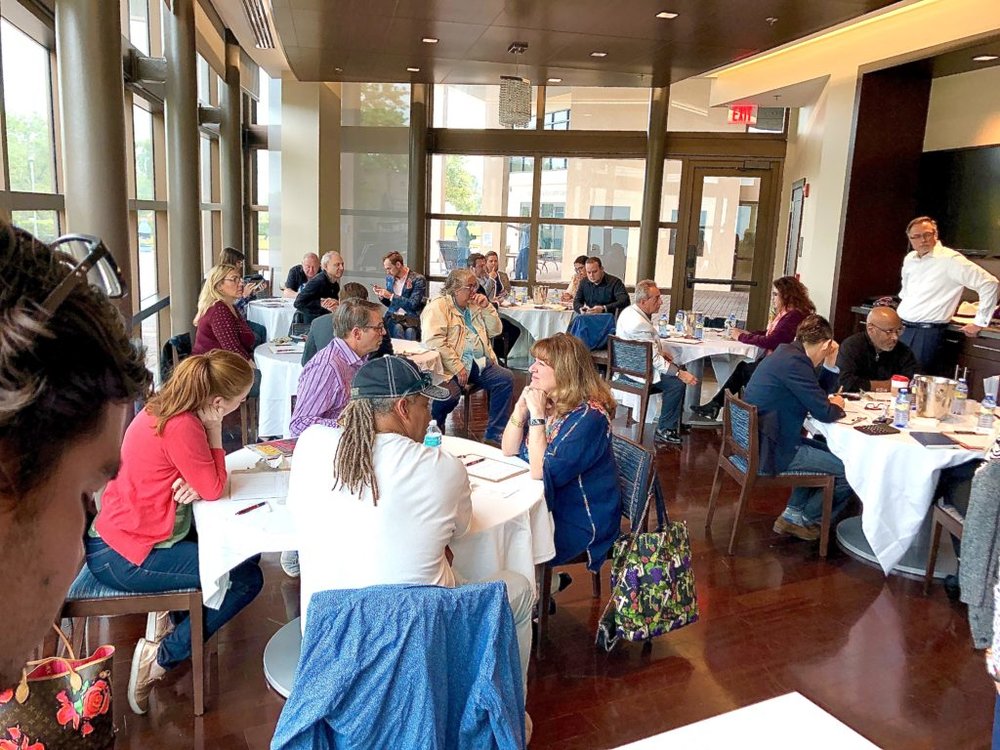
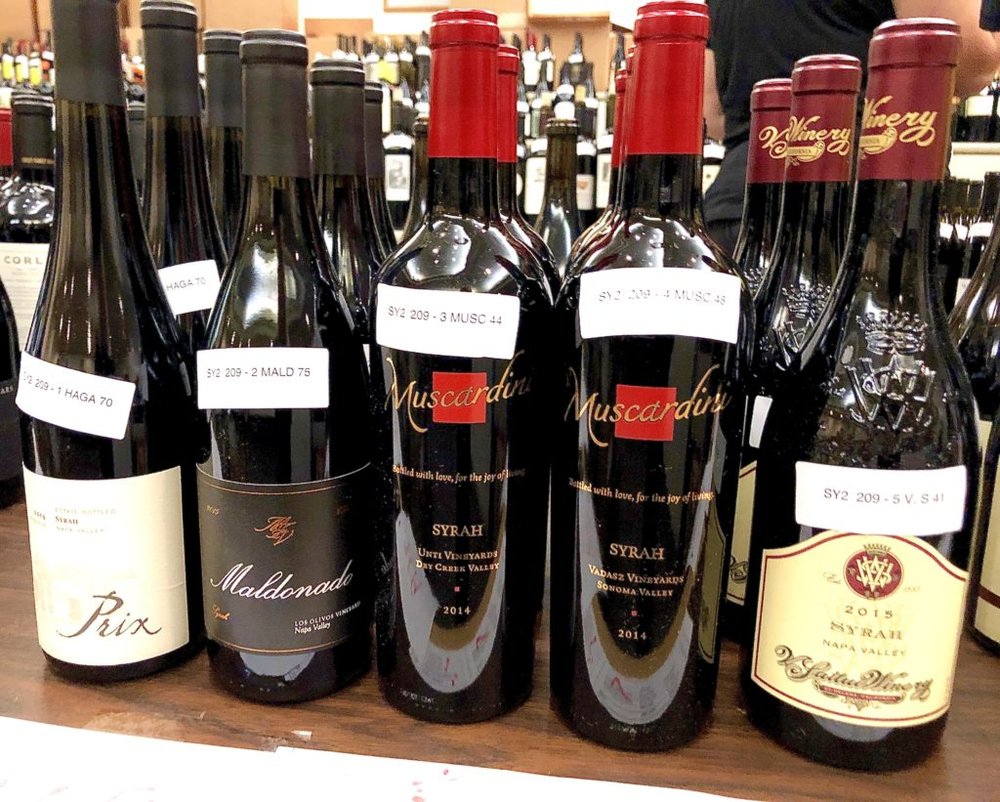
To view the complete list of results from the 12th Annual American Fine Wine Competition, please click here. Also, for more information on upcoming AFWC wine events, including the AFWC Gala, be sure to check out their calendar by clicking here.
Also, if you have any questions about any of the wines listed here or you'd like to share your thoughts, please feel free to message me in the comments sections below. To see results from previous years of the American Fine Wine Competition, simply click here.